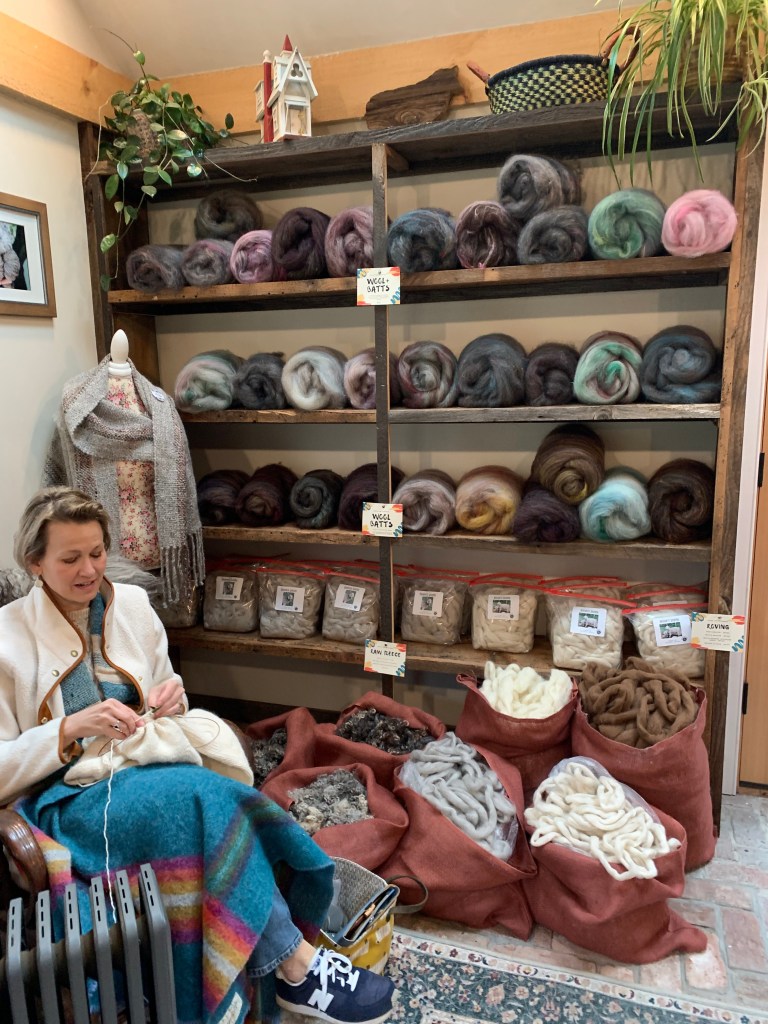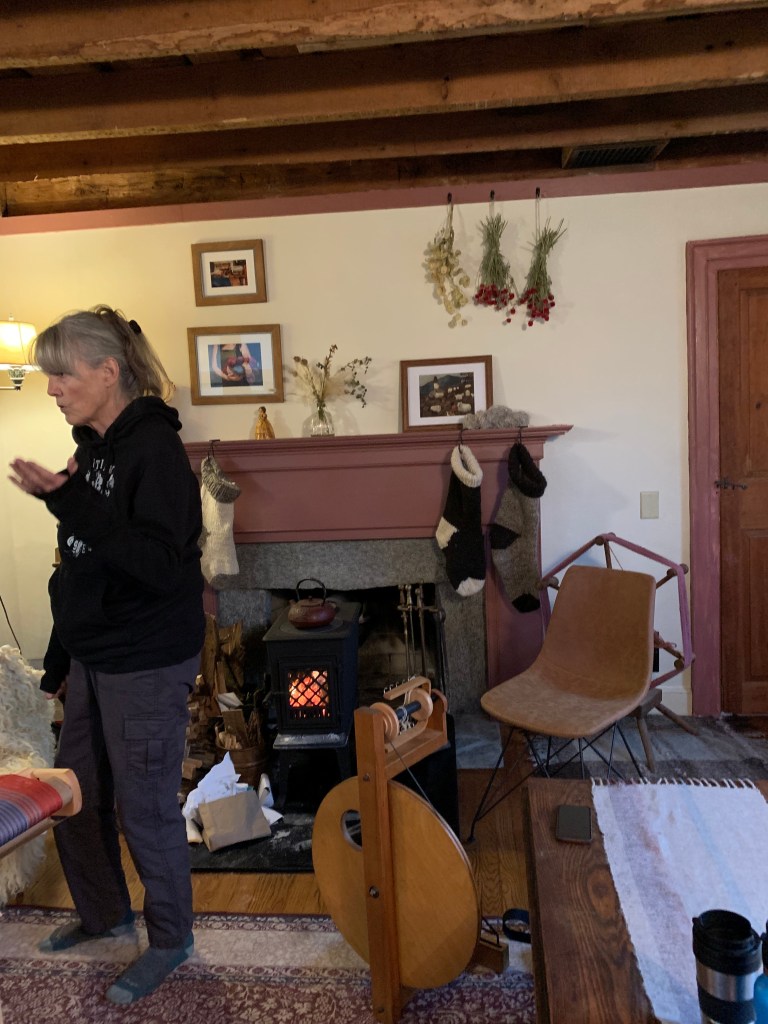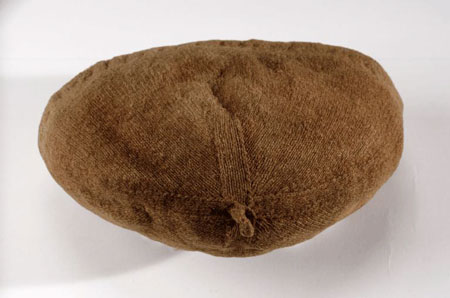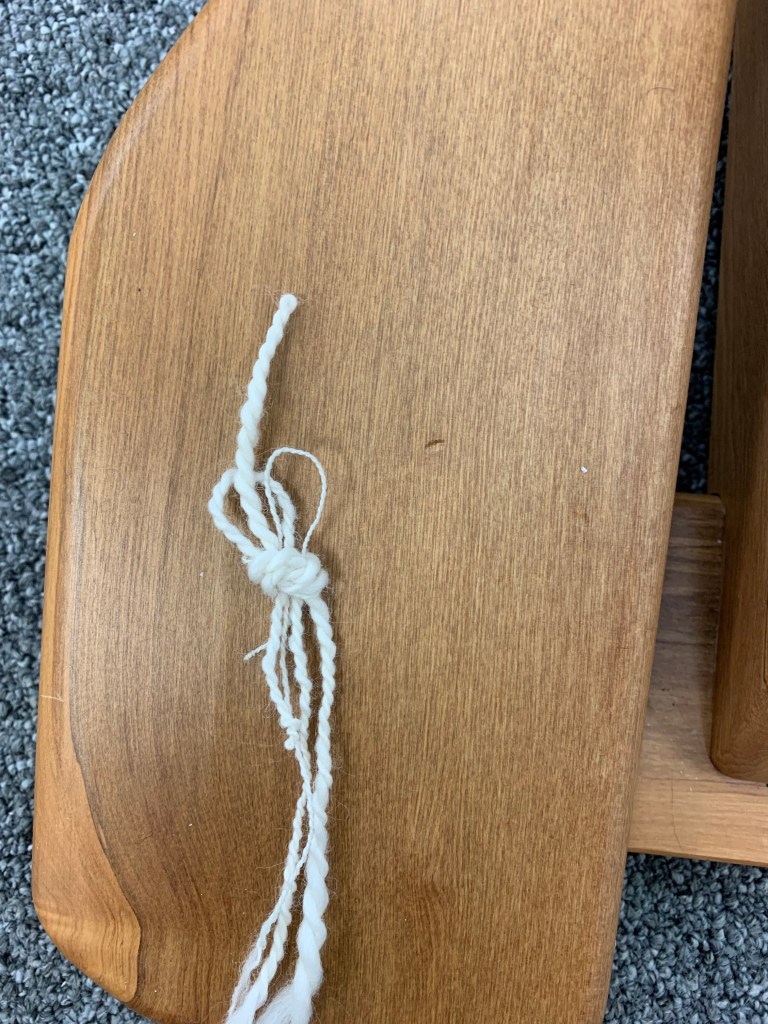
This time of year is great for craft fairs, concerts, art shows and markets. This past weekend was also an opportunity for an Open Studio at Maplewood Farm in Connecticut. I’ve been knitting with Heather’s yarns recently, and wanted to see if there was anything I should add to my stash for knitting later on.
I came home with “pre-yarn,” also known as roving…some alpaca and some mohair that will be blended with one of the more rustic fleece that are waiting in the wings. My goal is a 3-ply sock yarn that is both soft and sturdy. We’ll see what happens.






Heather (with a lovely bunny in her lap) is modeling the scarf/wrap I knit from her lace-weight BFL/mohair blend. Check out all of the rich colors she has dyed for this yarn. It’s really a joy to work with and so soft and cozy to wear right next to the skin. I’m hoping this will become her “go to” scarf to wear out and about when she wants something feather light, but still with a little warmth.
This isn’t my own pattern, but one I adapted from Erica Kemph Broughton of Nomad Yarns, called the LuAnn Scarf. I liked the original, but wanted it to be a little less lacy, so using US size 9 (rather than 11-13 from the pattern), I cast on 20 stitches in the green, and knit all rows until the scarf was about 5′ long. I then picked up stitches along one of the long sides using the purple. Picking up 1 for 1 gives you a slightly wavy ruffle, but I went for many extras by doing KFB in about every 7-10 stitches. After picking up, I knit until the ruffle was as wide as I wanted, and then cast off using Elizabeth Zimmerman’s sewn bind off.
I don’t recommend blocking this scarf as you’ll likely smash the mohair. If you need to, a light steaming will help to lubricate the stitches if you want to straighten the pick-up seam (I did, but was probably being much fussier than I needed to be).

The Open Studio idea is a great one, giving you time not only to do a little holiday shopping, but time to settle in for a while and catch up with friends and projects. I was so excited to see so many of the people I’d met at Heather’s spinning sessions in the summer. Both Erica Burrows (above left, knitting) and Judith Hooper (left here) were there (I’ve mentioned them in previous posts) as well as Sharon Geyer (shown above weaving) who bought my Ladybug Wheel. Just at the end, another knitter/spinner breezed in, and I failed to get a photo of Kate’s awesome color work sweater (a 3-year project finally completed.

But back to Heather and her studio and farm. One of the things I most admire about her is her ability to manage bunnies, goats and sheep (and I’m sure at least a half-dozen other animals), and still find time to knit, spin, and process wool and yarn for sale. Her eye for dye colors is outstanding, and it was all I could do not to go after that lovely fuchsia lace-weight. That color jumps off the shelf.
One of the very important projects she started this year was a flock of Racka sheep. Pronounced Ra-tska, these unusual sheep originated in Hungary, but there are now a few flocks in the US. They are generally raised for their milk and meat, but there is a growing interest in their fleece as well.
They are pretty shy with strangers, but so much fun to watch. Their fleece is quite lovely, and I was lucky to score a few ounces from Heather’s first shearing this year. Although the fleece is generally classed as “coarse,” I don’t find it so at all. I’ll review that later when I have some yarn to test. Like so much fleece, you have to let your hands learn its secrets in order to make a good yarn.
Heather’s plan is to breed for new starter flocks that she will be able to begin marketing this year. I frankly don’t know how she will be able to part from them when the time comes, since they are so amazingly special. I really have a problem with falling in love with all the sheep I meet. The only thing that saves me is the postage-stamp size of my yard!
Meanwhile….
I’m back to working on my “inspired by museum objects” projects. This little bag found in a bog in the Shetland Islands continues to haunt me. I’ve scoured the internet for references to the bag, and have read everything I could find in print, but there are a couple of issues with trying to knit a reproduction (not the least of which is its small size and fine gauge). First, there isn’t agreement on the upper edge. The cast on and loops for the drawstring are either the first row, or the stitches are cast on and there is 1 row of knitting before the loops. There also is disagreement on the ribbed section (2×2 or 2×3?), and about the bottom edge (grafted or 3 needle bind off).
The knitted objects from the burial site have undergone a new research evaluation since the original one in 1950, so I’m hoping to get some answers. Still, even knowing every aspect, an authentic reproduction will be difficult with commercial yarn. While I’ve recently “perfected” spinning fine two-ply, getting it to exactly the right grist is quite a challenge, and one I don’t expect to be perfectly successful. The biggest impediment is that the purse is on exhibit, and I will not be able to handle it to look at it carefully under magnification.

On my Needles
I’m also working on a first draft of a hat based on another of the Gunnister garments. The gentleman was buried with two hats, one of which was found in a pocket wrapped around a bone spoon.

There isn’t a cast on edge on the hat, which has apparently been cut and roughly hemmed. The hat has been fulled, and the top has been finished with a small loop. What got my attention were the crown decreases that form a cross shape. They inspired the finish for my Strawberry Starfish beret (which has 6 rather than 4 lines of decrease).
Another interesting feature is what has been described as a “boucle” finish to the cap interior. The yarn for the cap was a blend of Shetland and another more primitive fleece with longer coarse fibers. The two fibers in the yarn reacted differently to the fulling process creating the looped effect.
My first attempt at this hat will not try to re-create the fulled effect, but just the form with the interesting decreases. These have been described as both “paired and contrasting decreases worked on alternate rows with a panel of plain knitting in between.”*

This old black and white photo gives you an idea of what the lower edge looks like.

My other activity this weekend was a class to learn more about spinning to make knitting yarn. Here are just 3 samples. The one I’m most excited about is the very fine strand; a two ply that’s nearly as fine as sewing thread. Controlling both the tension and drafting allowed me to produce 3 distinct weights of yarn. Now I just have to make them consistent. This was a really satisfying class and learning experience.
That’s it for the moment. I need to get a loaf of Irish Soda Bread out of the oven and think about what’s for dinner. That means getting my head back to the real world and out of the bags of roving! Happy crafting until next time!
*Gunnister Man’s Knitted Possessions by Deborah Pulliam, Piecework Magazine, Sept/Oct 2002, p. 31